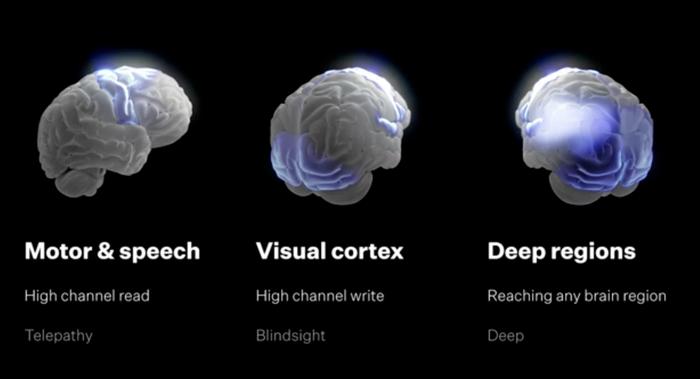
In the future, humans are expected to control humanoid robots directly through brain-machine interfaces.
On June 27th local time, Elon Musk’s company, Neuralink, released a one-hour video showcasing their latest research findings and product development directions.
In the video, Neuralink announced detailed development plans for the coming years: by the fourth quarter of 2025, Neuralink plans to implant chips in the speech cortex, aiming to directly decode silent “intent speech.”
By 2026, the number of electrodes implanted will increase to 3,000, with the first participant in the “Blindsight” project joining. This project uses cameras to capture images and converts them into electrical signals to stimulate the visual cortex, helping blind individuals regain sight.
By 2027, the number of electrodes will further increase to 10,000, achieving multi-device implantation, such as simultaneously implanting in the motor, speech, and visual cortices.
By 2028, the number of electrodes will exceed 25,000, reaching deeper brain regions, used for treating mental disorders, neuropathic pain, and beginning to explore deep integration with AI. Neuralink believes that if successful, by 2028, perhaps all humans could potentially connect with AI, turning into robots.
Neuralink’s ultimate goal is to build a “brain-computer interface,” which can write information to any part of the brain, enabling high-bandwidth connections between biological brains and external machines. These can be achieved through fully automated surgery, available 24/7.
Neuralink hopes to solve all known neurological diseases through implanting devices with hundreds of thousands or even millions of channels, even unlocking the full potential of the human brain, ushering in a new era.
Currently, Neuralink’s three products each have their own focus: “Telepathy” targets patients with motor disabilities such as spinal cord injuries and strokes, using high-channel devices to allow them to control computers and robotic arms with their thoughts, regaining the initiative in life; “Blindsight” aims to assist visually impaired individuals by transmitting information from the visual cortex through high-channel technology, aiding in the restoration of visual perception; “Deep” neuromodulation products are designed for patients with neurological disorders, mental health issues, and neuropathic pain, where electrodes are inserted into various brain regions to modulate neurons, enhancing treatment efficacy and quality of life.
It has been reported that Neuralink has already enrolled seven subjects, including four spinal cord injury patients and three amyotrophic lateral sclerosis (ALS) patients. These subjects are regularly using the relevant equipment, with data showing an average weekly usage time of about 50 hours, peaking at over 100 hours.
Of particular interest is the prospect of Alex, a spinal cord injury patient, connecting with Tesla’s humanoid robot Optimus to perform more complex operations in the future. Musk mentioned that in the future, people might be able to fully control Optimus’s body through Neuralink.
Neuralink was established in 2016, with its main research direction being brain-machine interfaces. By developing a device capable of being implanted in the brain, it aims to achieve “human brain interaction with machines.”
By the end of 2023, Neuralink announced the completion of the world’s first human brain-machine interface implantation trial. The chip, named “Telepathy,” measures the size of a coin, requiring the skull to be opened during implantation and 64 electrodes as fine as hairs to be inserted into the brain’s motor cortex to receive neural signals.
On June 2nd, local time, Neuralink announced that it had raised $650 million in its latest round of financing. Following the previous round of funding, Neuralink’s valuation had reached $9 billion. With this latest round of financing, the company’s valuation is expected to surpass $1 billion.